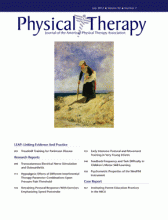Abstract
Background Daily experiences are thought to play an important role in motor development during infancy. There are limited studies on the effect of postural and movement experiences on head control.
Objective The purpose of this study was to quantify the effects of postural and movement experiences on head control through a comprehensive set of measurements beginning when infants were 1 month old.
Design This was a prospective, longitudinal, 2-cohort study.
Methods Twenty-two full-term infants who were healthy were randomly assigned to either a training group or a control group. Infants were observed every other week from 1 to 4 months of age. Head control was assessed using a standardized developmental assessment tool, the Test of Infant Motor Performance (TIMP), as well as behavioral coding and kinematics of infants' head postures and movements in a supported sitting position. Caregivers performed at least 20 minutes of daily postural and movement activities (training group), or social interaction (control group) for 4 weeks.
Results The training group had higher TIMP scores on head control–related items during the training period and after training stopped compared with the control group. Starting from the during training phase, the training group infants had their heads in a vertical and midline position longer compared with the control group infants. After training stopped, the training group infants actively moved their heads forward more often and for larger distances.
Limitations The experiences outside daily training were not monitored, and the results may be specific to the experimental setup for infants with typical development.
Conclusions Young infants are able to take advantage of postural and movement experiences to rapidly advance their head control as early as 4 to 6 weeks of postnatal life. Infant positioning, caregiver handling, and caregiver-infant interactions were likely contributing factors. This database of comprehensive measures may be useful in future trials focused on head control in infants with special needs.
Footnotes
Both authors provided concept/idea/research design, writing, and project management. Dr Lee provided data collection and analysis. Dr Galloway provided fund procurement, facilities/equipment, institutional liaisons, and consultation (including review of the manuscript before submission). The authors thank all of the infants and their parents for their effort and enthusiasm for participation. They also thank many undergraduate assistants for their help with data collection and processing.
- Received June 13, 2011.
- Accepted March 23, 2012.












